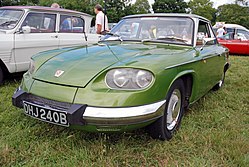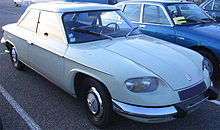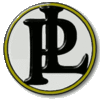Panhard 24
| Panhard | |
|---|---|
|
Panhard 24 CT (1964)
|
|
| 24 | |
| Sales designation: | 24 |
| Production period: | 1963-1967 |
| Class : | Lower middle class |
| Body versions : | Coupe |
| Engines: |
Petrol engines : 0.85 liters (37-44 kW) |
| Length: | 4260-4490 mm |
| Width: | 1620-1630 mm |
| Height: | 1220-1240 mm |
| Wheelbase : | 2300-2550 mm |
| Empty weight : | 830-840 kg |
The Panhard 24 is a passenger car made by Panhard & Levassor . It was the last civil model series to be manufactured under the Panhard brand name .
Presentation 1963
On June 24, 1963, the Panhard 24 was officially presented to the press in a garden near Montlhéry . In the midst of the extraordinary environment with roses and antique-looking statues, a vehicle in the striking colors light gray / roof and squeeze / body was exhibited on a platform in a pond, whereby squeeze ("plum") was a dark purple hue. The final athletic form surprised those present. Shortly before, a drawing had been published in the car magazine L'Auto-Journal, which was supposed to anticipate the design. The car shown here would also have been revolutionary for Panhard, as its trapezoidal shape clearly set it apart from the rounded Panhard PL 17 (from then on only as 17B / BT). The sporty 24 did this all the more. The shape of the vehicle came from Louis Bionier , the in-house designer who had joined Panhard & Levassor in 1921 and has since been responsible for many projects. At the time, it was surprising to many that a personality with such a long history in automotive engineering designed such a youthful vehicle. His last realization was the Citroën Dyane . Despite the elaborate presentation and the beautiful body, the trade press (and thus the customers) did not hide the fact that the vehicle had weaknesses on the drive side. However, the price compensated. Introduced on the French market at 11,100 FF, the 24 CT was marginally higher than the Renault Caravelle .
technology
The air-cooled two - cylinder boxer engine with 848 cm³ displacement had sack cylinders , like all post-war Panhard models. The cylinder heads were therefore not removable. Although this prevents leaks in a (non-existent) cylinder head gasket , it makes it much more difficult to overhaul the valve seat . Overall, the drive concept was considered outdated. The fuel consumption of just over 6 l / 100 km was comparatively low. The maximum output was also sufficient (for a two-cylinder engine it was even extraordinarily large), but there was a lack of power in the lower and middle speed range. In addition, the transmission had not been further developed over the years; it was not designed for high outputs of up to 60 hp. These problems were also known to the Panhard family. At this point in time, however, the financial means were lacking for a newly developed drive.
The body was self-supporting , but the drive and rear axle were each arranged on a subframe. Numerous outer panels were not welded as usual, but screwed. The curiosities of the chassis included two transverse leaf springs at the front and disc brakes with two brake calipers per wheel.
Another curiosity regarding the electrical system was the lack of fuses . Instead there was a main switch on the steering column that separated the battery from the rest of the electrical system. This worked as a good protection against theft, as many unauthorized users were unable to start the vehicle without knowing this feature. However, the car did not have a steering wheel lock, and the waiver of the protection of the individual circuits with fuses is technically questionable. The standard interior was extensive: There was a central heating and ventilation control with heating ducts for the rear window that ran through the doors. With the exception of models B and BA, the seats were height-adjustable in three stages. There were separate switches for parking lights and flasher. The illuminated glove box and the front passenger's sun visor with reading lamp were a real luxury at the time. There were even exit lights in the doors. The instruments in the BT and CT models included a trip meter, tachometer, fuel gauge, ammeter, timer and indoor thermometer. In some cases, a foldable and lockable rear seat back was installed. The double headlights placed behind glass are similar to those of the later D models of the shareholder in Panhard, Citroën.
Models
The new car was presented in two versions. On the one hand there was the 24 C , known as a sports sedan with four seats, on the other hand the 24 CT was offered, which was supposed to be a coupé with 2 + 2 seats. However, this classification was only a marketing-oriented disguise of the distinction between the inexpensive and the better equipped vehicle. In terms of space and dimensions, the model variants did not differ at all. In contrast, the C was equipped with the simpler engine that made 50 HP / SAE. There was also a greatly simplified dashboard , in which the instrument unit was taken from the Type 17 . The CT had the more powerful engine, traditionally called "Tigre" by Panhard, here in the Tigre 8 S version . This made 10 PS / SAE more, which meant 10 km / h more in the top speed. He also had circular advertisements reminiscent of the Panhard CD . In addition to a speedometer and rev counter , there was a clock, a fuel level indicator, an ammeter and an interior thermometer .
The star (L'Étoile)
The first modifications were made in March 1964. The gear selector lever, previously characterized by a semicircular shape, has been completely straightened. The glove compartment lid received a handle and was now easier to open. In addition, the lights in the door armrests, which were supposed to warn the following traffic when the doors were opened, were now made of chrome . Externally, these models can be recognized by a star (étoile) that accompanied the Panhards logo on the right rear fender . These vehicles were in great demand on the used car market for a long time and have remained so among Panhardists to this day. For model year 1965, the star was dropped again.
Realignment of the model series
The sales of the 24 fell short of expectations. The C in particular was disappointing. Logically, it was deleted from the program in October 1964 on the occasion of the Paris Motor Show . In parallel, the received CT a more powerful engine, the Tigre 10 S . With this, the car reached a top speed of 160 km / h. In order to do justice to the increased performance, the somewhat weak drum brakes previously used have been replaced by disc brakes .
The lack of economic success hit the company all the more because the 17 was no longer available to guarantee capacity and profit. Therefore the strategic decision was made to expand the range of the 24 with a sedan. Once again, Bionier was responsible for the design of the four-door model, but it did not get beyond the development phase. The realization was ultimately blocked by Citroën . The former competitor had become a partner and sold the Panhard models through its much larger dealer network. The basis for this approach was that the two brands did not compete directly. Work was carried out internally on Project F, which was strongly based on the Renault 16 . For this reason, those responsible for the Quai de Javel recommended that the Panhard family refrain from any further steps in this direction. In 1966, Project F was discarded shortly before production began.
The family complied, but used a stopgap solution. At the already mentioned Paris Salon, the 24 was presented as B and BT . The letter "B" stood for Berline, the French name for sedan. The body of the vehicles was extended by 25 cm, which benefited the legroom of the passengers on the back seat. Externally, the saloon could be distinguished from the coupé by the elongated rear window. The B took over the C's engine as well as the drum brakes and the dashboard. The BT was waiting with the instrumentation and the disc brakes of CT on, even he had a Tigre engine, but only the 8 S .
Critics accused the B and BT of diluting the harmony of the original concept with the extended body. Still, these vehicles became the most popular among buyers.
Economy model BA
The B models were successful, but they did not develop positively enough. The sales team therefore called for a savings model at an attack price. The company management complied with this request and presented the 24 BA in October 1965 .
The equipment of this car was reduced to a minimum. A dashboard with only a round speedometer and no glove compartment cover was combined with cheaply padded seats that could not be adjusted in any way. The simple door opening mechanism was adopted from the discontinued 17 . The tailgate was not held open by spring balances, but by rods, as were common on bonnets at the time. These and many other comparable details exuded a peculiar charm, which the customers punished with disregard despite the low price. Worse still: The company, known for its technically innovative and luxuriously equipped cars for its class, suffered serious damage in its image.
The double end
On April 23, 1965, Citroën had taken an absolute majority in Panhard. Since then, the 24 with the name Citroën-Panhard have been delivered on the nameplate. The owner family decided to take this step because they believed they could save their brand name and invest in the urgently needed development of a new engine. However, they were wrong. The manufacturing capacities for the production of the "box duck" Citroën Fourgonnette were increasingly rebuilt. In addition, all further developments were stopped on the 24th . So the plans for an elegant convertible and a station wagon not only disappeared in the drawer, but rather in the rubbish bin.
Against this background, the official end of production on July 20, 1967 was not surprising for Insider. Unlike many other vehicles, in which the last model built rolls off the assembly line into the museum, it was delivered here regularly. It went to a Pernod sales advisor in the BT trim level , in the company's blue-yellow colors and with a large brand name on both rear fenders.
So the history of the 24 to 28,945 car and at the same time the civil production of Panhard ended. This also ended a chapter in the 73-year history of France's oldest automobile manufacturer. Today the company only manufactures defense technology.
Citroën's development department also created a number of variants for the further development of the Model 24. For example, a four-cylinder boxer engine with more than 90 hp (66 kW) was developed from two Panhard engines. In 24 , however, it was not used, but was given to Panhard & Levassor for installation in armored vehicles. In addition, until the 1970s, Citroën used some 24-series bodies to test technology prototypes.
Model name
In the opinion of the Dynamic Club Panhard, one of the most important brand associations in France, which was in close contact with the former junior boss of the company Jean Panhard (1913–2014), the 24 has no particular significance. However, the possibility is granted that the name was inspired by the company's uninterrupted and sometimes successful participation in various vehicles in the Le Mans 24 Hours between 1950 and 1962 .
Technical specifications
| model | 24 C | 24 CT | 24 B | 24 BT | 24 BA |
|---|---|---|---|---|---|
| construction time | 1963-1964 | 1963-1967 | 1964-1967 | 1964-1967 | 1965-1967 |
| length | 4260 mm | 4260 mm | 4490 mm | 4490 mm | 4490 mm |
| width | 1620 mm | 1620 mm | 1630 mm | 1630 mm | 1630 mm |
| height | 1220 mm | 1220 mm | 1240 mm | 1240 mm | 1240 mm |
| wheelbase | 2300 mm | 2300 mm | 2550 mm | 2550 mm | 2550 mm |
| Empty weight | 830 kg | 830 kg | 840 kg | 840 kg | 835 kg |
| engine | M 8 | M 8S / M 10S | M 8 | M 8S | M 8 |
| Displacement | 848 cc | 848 cc | 848 cc | 848 cc | 848 cc |
| power | 50 HP (37 kW) | 60 hp (44 kW) | 50 HP (37 kW) | 60 hp (44 kW) | 50 HP (37 kW) |
| at speed | 5250 rpm | 5750-5800 rpm | 5250 rpm | 5750 rpm | 5250 rpm |
| Top speed | 140 km / h | 150-160 km / h | 140 km / h | 150 km / h | 135 km / h |
| Carburetor (Zenith) | 36 WIN | 38 NDIX | 36 WIN | 38 NDIX | 36 WIN |
| Production number | 1623 | 14473 | 2037 | 10651 | 161 |
literature
- Gazoline: Votre Auto - Le guide complet pour acheter, restaurer, entretenir, accessoiriser . No. 13: Panhard 24, Paris 2000
- Dominique Pagneux : Guide Panhard, Tous les modelès de 1945-1967 . E / P / A, Paris 1994
- Dominique Pagneux: Panhard, Le grand Livre . E / P / A, Paris 1996
Sources and web links
Individual evidence
- ↑ "Restored - Panhard 24 BT." in: Oldtimer Praxis 11/2017, pp. 8–13
- ↑ Jean-Louis Loubet: La GS, le succès né d'un échec , in: Gazonline, Issue 2 / February 2010, 15th year, Pixel Press Studio, Bailly, p. 8




